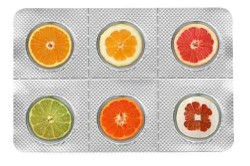What Is Vitamin C?
Vitamin C, also known as ascorbic acid, is a water soluble vitamin. Although an anti-scurvy factor had been isolated from citrus fruit in 1920 it was not until the early 1930s that the joint effort of Dr Albert Szent Gyorgi and Dr Charles Glen King chemically identified it.
It is excreted quickly (normally in two or three hours) though the body usually maintains a reserve supply of about 1.5 grams.
There have probably been more scientific controversies about this particular vitamin than about any other. Even today respected scientists and doctors differ strongly in their views as to what "powers" the vitamin has and how much you should have of it.
It is interesting to note that it is only humans, large primates (monkeys and apes) and several biological oddities such as the Indian fruit-eating bat who receive vitamin C from food sources alone. Other animals can produce it in their bodies.
What Does Vitamin C Do For You?
Vitamin C is used by so many parts of the body and, seemingly, does so many different things that it is often viewed as a sort of "cure-all".
- It is necessary for the growth and maintenance of the connective protein tissues that hold body cells together.
- It promotes the production of antibodies to fight against infection. The effectiveness of vitamin C supplements to prevent and/or cure the common cold is a continuing bone of contention between scientists.
- It helps the body cell building process and maintains the proper function of the central nervous system.
- It aids the body to absorb iron from plant sources.
- It is essential for the metabolism of fats and carbohydrates.
- It enables the adrenal in glands to function correctly.
- It is claimed that it fights toxic chemicals in the body (e.g. cancer producing substances from cigarettes etc.).
- High dosage supplements of C have been claimed to be effective in the battle against cancer though there is no conclusive proof of this.
- It helps control blood cholesterol levels - though there is divided opinion on this point.
Food Sources
Important
- Fresh fruit - citrus, tropical, berry fruits (100g serving)
- Vegetables - green and leafy e.g. broccoli, cauliflower,
- Brussels sprouts, cabbage, spinach (60- 100g serving)
Note. An Australian bush fruit - a green plum that grows around Darwin - may be the richest natural source of vitamin C in the world. This wild fruit has fifty times the vitamin C content of oranges. The discovery was made by Sydney University's Human Nutrition Unit in their study (1981/82) of bush foods used by Australian Aborigines.
Moderate
- Fresh fruit - apples, stone fruits (100g serving),
- avocado pear (150g / 1/2)
- Liver (100g serving)
- Milk (250ml serving)
- Fresh vegetables - peas, pumpkin, sweetcorn (100g serving), potatoes (120g serving)
Low or Nil
- Cereals
- Meat
- Fish
- Cheese
- Nuts
- Yeast products
- Fats and oils
What Destroys Vitamin C?
Vitamin C is the most fragile of all the vitamins. It can be easily destroyed in the cooking process since C is soluble in water and killed by heat. The familiar sight of over cooked, soggy Brussels sprouts would be a classic example of vitamin C destruction.
Exposure to oxygen and light causes vitamin loss.
This oxidization process is increased by traces of iron and copper. Therefore the type of cooking pot used is an important factor in vitamin retention.
Bruised or wilting fruit and vegetables release enzymes which kill the vitamin. For example, freshly squeezed orange juice in babies' bottles quickly loses its vitamin C.
The old-fashioned practice of adding bicarb soda (an alkali) to the boiling beans in order to preserve their "fresh green look" actually destroys vitamin C.
Deficiency Problems and Symptoms
Scurvy, a direct result of a severe lack of vitamin C, is probably the longest recognised deficiency disease.
The Greeks and the Romans were aware of it but did not know how to treat it. From the time of the great European sea explorations it was a very common cause of illness and death among sailors who could not eat fresh food, particularly fruits and vegetables, during the long sea voyage.
It is theoretically eliminated from modern society but it is quite possible for 'even affluent members of today's Western communities to become ill from scurvy if their diet is completely lacking in fresh fruits and vegetables.
A diet built around steak and eggs, spaghetti and meat balls, white bread, coffee and sweet biscuits or cakes may be tastier than the salt beef and dry biscuits sailors had to eat aboard ships a hundred and more years ago, but both lack the essential vitamin C necessary to ward off scurvy.
There had been many early reports of "fruits" of various kinds being used to cure scurvy. Finally, in 1753, Dr James Lind, an eighteenth century Englishman, published his famous A Treatise on Scurvy, In this he suggested that sailors needed the addition of lime or lemon juice in their diet to keep them free of scurvy. This suggestion was not acted upon until years later when Captain James Cook became one of the foremost advocates of juice supplements for his crews. In 1795 the British Navy began issuing daily rations of lime juice to sailors, Hence the nickname "limey" for English sailors and Englishmen in general.
Among the physical symptoms of deficiency are weakness, muscular pain, moodiness, a discolored and swollen tongue, bleeding gums and tissue.
Recommended Daily Intake
This is an area of great controversy. The government publication Dietary allowances for use in Australia sums up the situation very well: "The actual minimum amounts of vitamin C that will prevent scurvy in humans are probably quite low, of the order of 10-20 milligrams per day. However, it is not known whether there are appreciable benefits if the diet contains greater amounts ... a positive statement of desirable human allowance is difficult to make .. . "
The Australian recommendation has been set at 30 milligrams per day, increasing to 60 during pregnancy and while breast feeding.
This intake is well above the minimum required to prevent scurvy.
Toxicity
There are no thoroughly proven toxic effects although side effects such as diarrhoea, skin problems and even kidney stones have been noted as results of extremely large doses. It has also been claimed that megadoses of C could lower the body's ability to absorb vitamin B12.
The effects of certain drugs (including the Pill and certain anti blood-clotting drugs) are known to be altered by a large intake of C.
To summarize: too little is known about the ultimate effects of large doses of vitamin C on the body.
You might also like
The Common ColdThe Cold is the most common ailment which afflicts man.
AcneAcne is an inflammation of the skin centered in the Sebaceous Glands.





 Your rash and itching problems may be Scabieson 03/10/2013
Your rash and itching problems may be Scabieson 03/10/2013
 Tickson 11/06/2011
Tickson 11/06/2011
 Vitamin Kon 10/10/2011
Vitamin Kon 10/10/2011
 Vitamin Eon 10/10/2011
Vitamin Eon 10/10/2011



Comments
Thanks for the link - very interesting info. :)
I've added a link to the article. I've not personally had experience with the fruit. There is a lot of interesting fruits and vegetables to be found in the Australian outback. If you ever get a chance to see the television show the "Bush Tucker Man", do so.
I wonder about this green plum. It must be very sour. Have you ever tried it? Is it available outside the bush? What's the name?